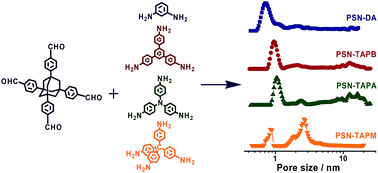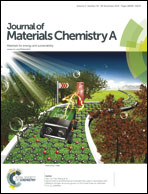Micro- and mesoporous poly(Schiff-base)s constructed from different building blocks and their adsorption behaviors towards organic vapors and CO2 gas†
Abstract
Four porous poly(Schiff-base)s, PSN-DA, PSN-TAPB, PSN-TAPA and PSN-TAPM, are synthesized via one-pot condensation from 1,3,5,7-tetrakis(4-formylphenyl)adamantane with rod-like m-phenyldiamine, triangular 1,3,5-tris(4-aminophenyl)benzene and tris(4-aminophenyl)amine as well as tetrahedral tetrakis(4-aminophenyl)methane, respectively. It is found that the variation of the geometrical shape of the building blocks significantly alters the surface areas, pore sizes and distributions of the resultant porous polymers and thereby remarkably influences their adsorption behaviors towards organic vapors and CO2 gas. PSN-DA, PSN-TAPB and PSN-TAPA are microporous materials with pore sizes of 0.72, 0.95 and 1.04 nm, whereas PSN-TAPM is a micro- and mesoporous material with the major pores centered at 0.86 and 2.62 nm, respectively. Their BET surface areas are in the range from 419 to 1045 m2 g−1. At P/Po = 0.9 and 298 K, PSN-DA possesses high uptakes for both aromatic vapor (benzene, 86.1 wt%) and aliphatic vapor (cyclohexane, 77.9 wt%). In addition, the adsorption and desorption isotherms of CO2 gas in the four porous polymers are reversible – a characteristic which is convenient for the regeneration of CO2 adsorbents. Their adsorption capacities of CO2 are up to 15.0 wt% (273 K/1 bar) with the ideal selectivities of CO2/N2 and CO2/CH4 up to 71 and 14, respectively. showing potential applications in the removal of toxic organic vapors and capture of CO2 from air.


 Please wait while we load your content...
Please wait while we load your content...